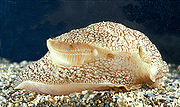
Ctenidium (mollusc)
Encyclopedia

Ctenidium
Ctenidium may be:* Ctenidium , , a comb-like gill, part of the respiratory system of gastropods and bivalves* Ctenidium, , a row of peg-like spines in some insects...
is a respiratory organ or gill
Gill
A gill is a respiratory organ found in many aquatic organisms that extracts dissolved oxygen from water, afterward excreting carbon dioxide. The gills of some species such as hermit crabs have adapted to allow respiration on land provided they are kept moist...
which is found in many mollusks. This structure exists in bivalves and in many aquatic gastropods, i.e. in some freshwater snail
Freshwater snail
A freshwater snail is one kind of freshwater mollusc, the other kind being freshwater clams and mussels, i.e. freshwater bivalves. Specifically a freshwater snail is a gastropod that lives in a watery non-marine habitat. The majority of freshwater gastropods have a shell, with very few exceptions....
s and sea snail
Sea snail
Sea snail is a common name for those snails that normally live in saltwater, marine gastropod molluscs....
s and also in some sea slug
Sea slug
Sea slug is a common name used for several different groups of saltwater snails that either lack a shell or have only an internal shell, in other words this name is used for various lineages of marine gastropod mollusks that are either not conchiferous or appear not to be.The phrase "sea slug" is...
s. Some aquatic gastropods possess one ctenidium, others have a pair of ctenidia (the plural form of the word).
A ctenidium is shaped like a comb or a feather, with a central part from which many filaments or plate-like structures protrude, lined up in a row. The word is latinized but is derived from the Greek
Ancient Greek
Ancient Greek is the stage of the Greek language in the periods spanning the times c. 9th–6th centuries BC, , c. 5th–4th centuries BC , and the c. 3rd century BC – 6th century AD of ancient Greece and the ancient world; being predated in the 2nd millennium BC by Mycenaean Greek...
ktenidion which means "little comb", being a diminutive of the word kteis meaning comb.

